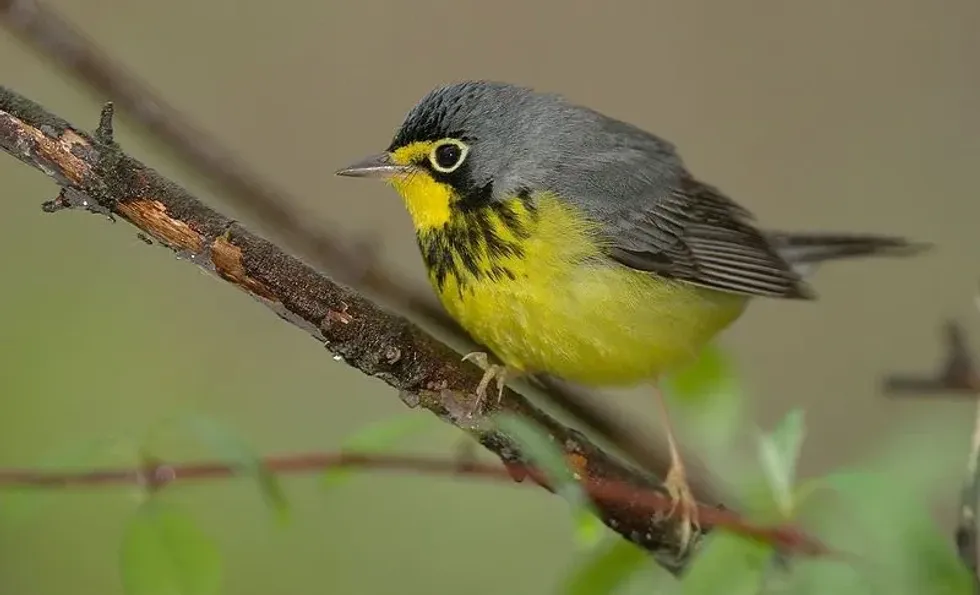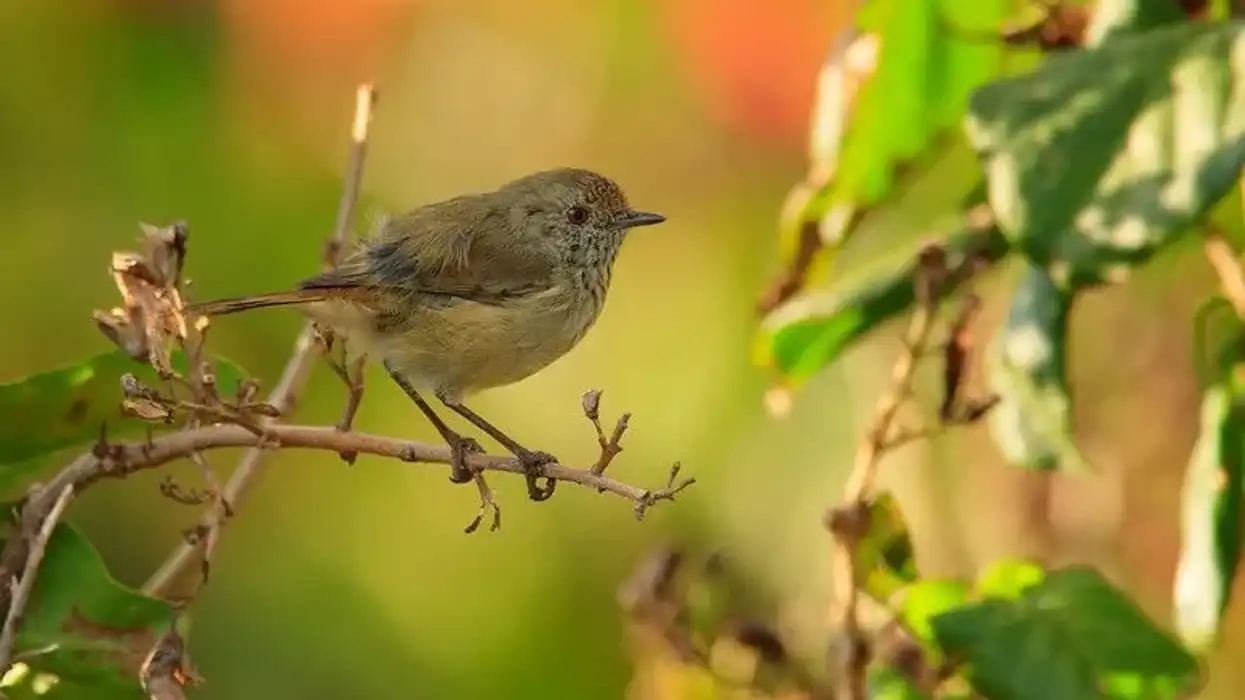The Canada warbler (Cardellina canadensis), sometimes called the necklaced warbler, is a colorful songbird found in North America and South America. According to the Cornell Lab of Ornithology, the best place to locate Canada warblers is in deciduous regions or forests covered with moss and ferns, forest wetlands, or rhododendron plantations.
To identify one, you will have to have to look for sharp and fast movements in the undergrowth as they hop and flick their wings while moving from one branch to another.
During the breeding season, Canada warblers are one of the last birds to reach the breeding grounds and also among the first ones to leave. Canada warblers are among the very few birds that fly over 3000 mi (4828 km) to reach the breeding grounds.
While Canada warblers are the most colorful warblers among the others such as aquatic warblers and yellow warblers, they are difficult to locate due to their declining population with each passing year.
If you like what you read, do check out our articles on mourning warblers and yellow warblers.
Canada Warbler Interesting Facts
What type of animal is a Canada warbler?
A Canada warbler is a beautiful species of songbird that spends most of its time in forest wetlands and it feeds on insects, flies, spiders, and on fruits occasionally.
What class of animal does a Canada warbler belong to?
The Canada warbler is a bird belonging to the Parulidae family. Its scientific name is Cardellina canadensis.
How many Canada warblers are there in the world?
There are around 2.7 million Canada warblers in the world.
Where does a Canada warbler live?
This species of bird is usually found breeding in Canada but can also be located in the Appalachian region.
What is a Canada warbler's habitat?
A Canada warbler is not shy but it can be a bit difficult to locate as they are found hopping from branch to branch in forest undergrowths and thickets. You can locate them near river banks, mixed coniferous forests, moist deciduous forests, and most importantly near rhododendron plantations.
In the winter, they usually migrate to heavily dense undergrowths and scrubs in the northern part of South America.
Who do Canada warblers live with?
After being born at the end of the nesting period, Canada warblers stay with their parents for roughly two weeks while their wing starts to form. During the nesting period, females look for small corners around an uprooted tree or near a thicket of moss.
How long does a Canada warbler live?
The exact accurate lifespan of a Canada warbler is unknown but it is estimated that this bird can live for around eight years.
How do they reproduce?
These birds are usually monogamous but they are seen wintering at different heights. Males are the first ones to arrive at the breeding grounds during the onset of spring.
On the other hand, female warblers are seen making their nests at ground level in the southern region of Canada. A Canada warbler female produces four to five eggs and then incubates for roughly around ten to twelve days. While females incubate, male birds fly a bit higher than the breeding grounds to forage for food.
What is their conservation status?
According to the breeding bird survey of Canada, Canada warblers are among the most threatened North American birds due to the continuous loss of wetlands and extensive deforestation. Though the IUCN Red List of Threatened Species has listed them as Least Concerned. The Canada Warbler International Conservation Initiative (CWICI) was set up in 2013 to conserve this species.
According to figures, around 85% of the total population of Canada warblers breed in Canada and that is the main reason to conserve this species of bird. Conservation is carried out on an international scale as a major part of the population is threatened during migration.
Efforts are being made to develop fresh winter grounds for these birds in the southern part and the central part of America.
Canada Warbler Fun Facts
What do Canada warblers look like?
Canada warblers are one of the most colorful North American birds. You can easily differentiate between the two sexes. The color of a male is brighter than that of a female.
According to the Cornell Lab of Ornithology, these birds are usually steely gray and yellow and they have a white eye ring. They are often called 'necklace warblers' as they have black stripes across their chest which look like a necklace.
While the tail and the upper region of this bird are gray, the breast region is yellow. A male bird also has black feathers on its forehead and near its eyes. This species of bird do not shed during any season.
How cute are they?
This species is extremely cute especially because of its bright colors and gleeful behavior. They are really small which makes them even cuter.
How do they communicate?
A Canada warbler call can be identified by a shrill chirp followed by a pleasant warble. What is unique about these birds is that they have two unique song styles which are also called the Canada warbler song.
During the daytime which marks Mode 1, when a male is without a female, he sings the same song to attract females. And later during the day in Mode 2, when he has found a female, he sings various songs with variations in rhythm and chirping.
How big is a Canada warbler?
This species of bird is one of the smallest creatures of wildlife. They are usually 4.7- 5.9 in (12- 15 cm) in length and have a wingspan of around 8-9 in (20-22 cm).
How fast can a Canada warbler fly?
The exact speed is unknown but they are quite fast and since they are small, they can be hard to locate. During the breeding period, you can see females hopping near their nests in the forested wetlands in fast and sharp movements.
How much does a Canada warbler weigh?
The weight of this bird range from 0.3-0.5 oz (9- 13 g).
What are the male and female names of the species?
Both sexes of this species are known by their scientific name, Cardellina canadensis.
What do you call a baby Canada warbler?
A baby warbler is called a chick or it can also be called a juvenile.
What do they eat?
As we know Canada warblers are North American birds and they live on the forest ground. They feed on beetles, moths, cankerworms, snails, worms, and also fruits on rare occasions. During migration and breeding, the majority of the female population depends on males for food.
Are they dangerous?
It is a treat to the eyes to watch them flying. They are not dangerous and are not a threat to humans.
Would they make a good pet?
They can make a good pet but since bird conservation is a real issue, they should be left free. This will not only keep them away from threats but will also let them increase their population in the central region of Canada.
Did you know...
The population of this species is declining every year at a steady rate of 4 to 7%.
The main reason behind the decline in the population is the clearing of forests for commercial use or converting forests to harvesting grounds.
How do you identify a warbler?
To identify a Canada warbler (Cardellina canadensis), you should look for a white eye ring and black stripes near the chest which will look similar to a necklace. Also, the colors of the breasts and tail region are different.
Another way to identify a warbler is by using your ears. They call out with a shrill voice followed by a warble.
Why are they called warblers?
Old World oscine birds are called warblers. 'Warblers' refers to a songster or the one who sings. These birds are well known for their singing capability and that is how they got their name.
Here at Kidadl, we have carefully created lots of interesting family-friendly animal facts for everyone to discover! Learn more about some other birds including myna bird or pitta bird.
You can even occupy yourself at home by drawing one on our Canada Warbler coloring pages.










